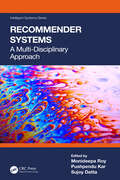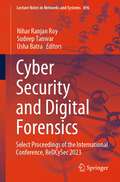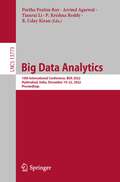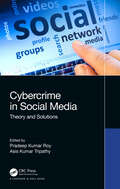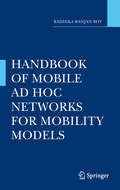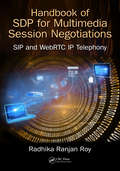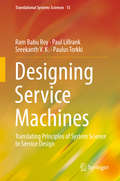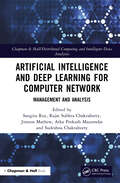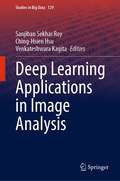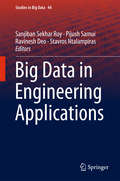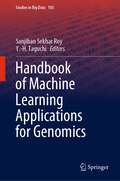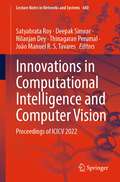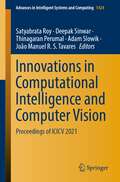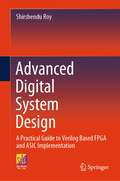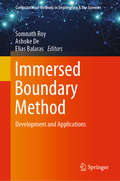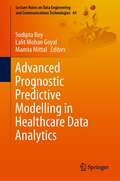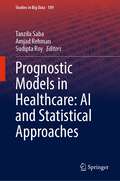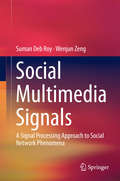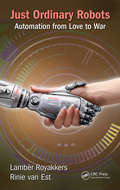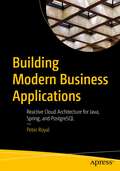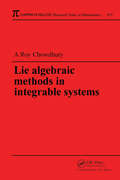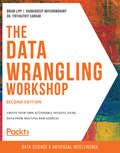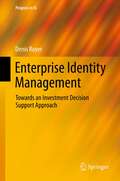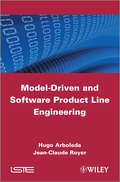- Table View
- List View
Recommender Systems: A Multi-Disciplinary Approach (Intelligent Systems)
by Monideepa Roy Pushpendu Kar Sujoy DattaRecommender Systems: A Multi-Disciplinary Approach presents a multi-disciplinary approach for the development of recommender systems. It explains different types of pertinent algorithms with their comparative analysis and their role for different applications. This book explains the big data behind recommender systems, the marketing benefits, how to make good decision support systems, the role of machine learning and artificial networks, and the statistical models with two case studies. It shows how to design attack resistant and trust-centric recommender systems for applications dealing with sensitive data. Features of this book: Identifies and describes recommender systems for practical uses Describes how to design, train, and evaluate a recommendation algorithm Explains migration from a recommendation model to a live system with users Describes utilization of the data collected from a recommender system to understand the user preferences Addresses the security aspects and ways to deal with possible attacks to build a robust system This book is aimed at researchers and graduate students in computer science, electronics and communication engineering, mathematical science, and data science.
Cyber Security and Digital Forensics: Select Proceedings of the International Conference, ReDCySec 2023 (Lecture Notes in Networks and Systems #896)
by Nihar Ranjan Roy Sudeep Tanwar Usha BatraThe book contains peer-reviewed papers from the International Conference on Recent Developments in Cyber Security organized by the Center for Cyber Security and Cryptology at Sharda University in June 2023. This volume focuses on privacy and secrecy of information, cryptography, applications and analysis, cyber threat intelligence and mitigation, cyber-physical systems, cyber threat intelligence, quantum cryptography and blockchain technologies and their application, etc. This book is a unique collection of chapters from different areas with a common theme and will be immensely useful to academic researchers and practitioners in the industry.
Dynamic Formal Epistemology
by Olivier Roy Patrick Girard Mathieu MarionThis volume is a collation of original contributions from the key actors of a new trend in the contemporary theory of knowledge and belief, that we call "dynamic epistemology". It brings the works of these researchers under a single umbrella by highlighting the coherence of their current themes, and by establishing connections between topics that, up until now, have been investigated independently. It also illustrates how the new analytical toolbox unveils questions about the theory of knowledge, belief, preference, action, and rationality, in a number of central axes in dynamic epistemology: temporal, social, probabilistic and even deontic dynamics.
Big Data Analytics: 10th International Conference, BDA 2022, Hyderabad, India, December 19–22, 2022, Proceedings (Lecture Notes in Computer Science #13773)
by Partha Pratim Roy Arvind Agarwal Tianrui Li P. Krishna Reddy R. Uday KiranThis book constitutes the proceedings of the 10th International Conference on Big Data Analytics, BDA 2022, which took place in Hyderabad, India, in December 2022.The 7 full papers and 7 short papers presented in this volume were carefully reviewed and selected from 36 submissions. The book also contains 4 keynote talks in full-paper length. The papers are organized in the following topical sections: Big Data Analytics: Vision and Perspectives; Data Science: Architectures; Data Science: Applications; Graph Analytics; Pattern Mining; Predictive Analytics in Agriculture.
Cybercrime in Social Media: Theory and Solutions
by Pradeep Kumar Roy Asis Kumar TripathyThis reference text presents the important components for grasping the potential of social computing with an emphasis on concerns, challenges, and benefits of the social platform in depth. Features: Detailed discussion on social-cyber issues, including hate speech, cyberbullying, and others Discusses usefulness of social platforms for societal needs Includes framework to address the social issues with their implementations Covers fake news and rumor detection models Describes sentimental analysis of social posts with advanced learning techniques The book is ideal for undergraduate, postgraduate, and research students who want to learn about the issues, challenges, and solutions of social platforms in depth.
Handbook of Mobile Ad Hoc Networks for Mobility Models
by Radhika Ranjan RoyThe Mobile Ad Hoc Network (MANET) has emerged as the next frontier for wireless communications networking in both the military and commercial arena. Handbook of Mobile Ad Hoc Networks for Mobility Models introduces 40 different major mobility models along with numerous associate mobility models to be used in a variety of MANET networking environments in the ground, air, space, and/or under water mobile vehicles and/or handheld devices. These vehicles include cars, armors, ships, under-sea vehicles, manned and unmanned airborne vehicles, spacecrafts and more. This handbook also describes how each mobility pattern affects the MANET performance from physical to application layer; such as throughput capacity, delay, jitter, packet loss and packet delivery ratio, longevity of route, route overhead, reliability, and survivability. Case studies, examples, and exercises are provided throughout the book. Handbook of Mobile Ad Hoc Networks for Mobility Models is for advanced-level students and researchers concentrating on electrical engineering and computer science within wireless technology. Industry professionals working in the areas of mobile ad hoc networks, communications engineering, military establishments engaged in communications engineering, equipment manufacturers who are designing radios, mobile wireless routers, wireless local area networks, and mobile ad hoc network equipment will find this book useful as well.
Handbook of SDP for Multimedia Session Negotiations: SIP and WebRTC IP Telephony
by Radhika Ranjan RoyThis book on SDP is the first of this kind that attempts to put all SDP related RFCs together with their mandatory and optional texts in a chronological systematic way as if people can use a single “super-SDP RFC” with almost one-to-one integrity from beginning to end to see the big picture of SDP in addition to base SDP functionalities.
Designing Service Machines: Translating Principles of System Science to Service Design (Translational Systems Sciences #15)
by Ram Babu Roy Paul Lillrank Sreekanth V. K. Paulus TorkkiThis book presents a general conceptual framework to translate principles of system science and engineering to service design. Services are co-created immaterial, heterogeneous, and perishable state changes. A service system includes the intended benefit to the customer and the structure and processes that accomplish this benefit. The primary focus is on the part of the service system that can reproduce such processes, called here a Service Machine, and methodological guidelines on how to analyze and design them. While the benefit and the process are designed based on the domain knowledge of each respective field, service production systems have common properties. The Service Machine is a metaphor that elicits the fundamental characteristics of service systems that do something efficiently, quickly, or repeatedly for a defined end. A machine is an artifact designed for a purpose, has several parts, such as inputs, energy flows, processors, connectors, and motors assembled as per design specifications. In case of service machine, the components are various contracts assembled on contractual frames. The book discusses Emergency Medical Services (EMS) and Emergency Departments (ED) as cases. They illustrate that service machines need to be structured to adapt to the constraints of the served market acknowledging the fact that services are co-created through the integration of producers’ and customers’ resources. This book is highly recommended for those who are interested in understanding the fundamental concepts of designing service machines.
Artificial Intelligence and Deep Learning for Computer Network: Management and Analysis (Chapman & Hall/Distributed Computing and Intelligent Data Analytics)
by Sangita Roy Rajat Subhra Chakraborty Jimson Mathew Arka Prokash Mazumdar Sudeshna ChakrabortyArtificial Intelligence and Deep Learning for Computer Network: Management and Analysis aims to systematically collect quality research spanning AI, ML, and deep learning (DL) applications to diverse sub-topics of computer networks, communications, and security, under a single cover. It also aspires to provide more insights on the applicability of the theoretical similitudes, otherwise a rarity in many such books. Features: A diverse collection of important and cutting-edge topics covered in a single volume. Several chapters on cybersecurity, an extremely active research area. Recent research results from leading researchers and some pointers to future advancements in methodology. Detailed experimental results obtained from standard data sets. This book serves as a valuable reference book for students, researchers, and practitioners who wish to study and get acquainted with the application of cutting-edge AI, ML, and DL techniques to network management and cyber security.
Deep Learning Applications in Image Analysis (Studies in Big Data #129)
by Sanjiban Sekhar Roy Ching-Hsien Hsu Venkateshwara KagitaThis book provides state-of-the-art coverage of deep learning applications in image analysis. The book demonstrates various deep learning algorithms that can offer practical solutions for various image-related problems; also how these algorithms are used by scientists and scholars in industry and academia. This includes autoencoder and deep convolutional generative adversarial network in improving classification performance of Bangla handwritten characters, dealing with deep learning-based approaches using feature selection methods for automatic diagnosis of covid-19 disease from x-ray images, imbalance image data sets of classification, image captioning using deep transfer learning, developing a vehicle over speed detection system, creating an intelligent system for video-based proximity analysis, building a melanoma cancer detection system using deep learning, plant diseases classification using AlexNet, dealing with hyperspectral images using deep learning, chest x-ray image classification of pneumonia disease using efficient net and inceptionv3.The book also addresses the difficulty of implementing deep learning in terms of computation time and the complexity of reasoning and modelling different types of data where information is currently encoded. Each chapter has the application of various new or existing deep learning models such as Deep Neural Network (DNN) and Deep Convolutional Neural Networks (DCNN). The detailed utilization of deep learning packages that are available in MATLAB, Python and R programming environments have also been discussed, therefore, the readers will get to know about the practical implementation of deep learning as well. The content of this book is presented in a simple and lucid style for professionals, nonprofessionals, scientists, and students interested in the research area of deep learning applications in image analysis.
Big Data in Engineering Applications (Studies in Big Data #44)
by Sanjiban Sekhar Roy Pijush Samui Ravinesh Deo Stavros NtalampirasThis book presents the current trends, technologies, and challenges in Big Data in the diversified field of engineering and sciences. It covers the applications of Big Data ranging from conventional fields of mechanical engineering, civil engineering to electronics, electrical, and computer science to areas in pharmaceutical and biological sciences. This book consists of contributions from various authors from all sectors of academia and industries, demonstrating the imperative application of Big Data for the decision-making process in sectors where the volume, variety, and velocity of information keep increasing. The book is a useful reference for graduate students, researchers and scientists interested in exploring the potential of Big Data in the application of engineering areas.
Handbook of Machine Learning Applications for Genomics (Studies in Big Data #103)
by Sanjiban Sekhar Roy Y. H. TaguchiCurrently, machine learning is playing a pivotal role in the progress of genomics. The applications of machine learning are helping all to understand the emerging trends and the future scope of genomics. This book provides comprehensive coverage of machine learning applications such as DNN, CNN, and RNN, for predicting the sequence of DNA and RNA binding proteins, expression of the gene, and splicing control. In addition, the book addresses the effect of multiomics data analysis of cancers using tensor decomposition, machine learning techniques for protein engineering, CNN applications on genomics, challenges of long noncoding RNAs in human disease diagnosis, and how machine learning can be used as a tool to shape the future of medicine. More importantly, it gives a comparative analysis and validates the outcomes of machine learning methods on genomic data to the functional laboratory tests or by formal clinical assessment. The topics of this book will cater interest to academicians, practitioners working in the field of functional genomics, and machine learning. Also, this book shall guide comprehensively the graduate, postgraduates, and Ph.D. scholars working in these fields.
Innovations in Computational Intelligence and Computer Vision: Proceedings of ICICV 2022 (Lecture Notes in Networks and Systems #680)
by Satyabrata Roy Deepak Sinwar Nilanjan Dey Thinagaran Perumal João Manuel R. S. TavaresThis book presents high-quality, peer-reviewed papers from the International Conference on “Innovations in Computational Intelligence and Computer Vision (ICICV 2022),” hosted by Manipal University Jaipur, Rajasthan, India, on 24–25 November 2022. The book includes a collection of innovative ideas from researchers, scientists, academics, industry professionals and students. The book covers a variety of topics, such as artificial intelligence and computer vision, image processing and video analysis, applications and services of artificial intelligence and computer vision, interdisciplinary areas combining artificial intelligence and computer vision, and other innovative practices.
Innovations in Computational Intelligence and Computer Vision: Proceedings of ICICV 2021 (Advances in Intelligent Systems and Computing #1424)
by Satyabrata Roy Deepak Sinwar Thinagaran Perumal Adam Slowik João Manuel R. S. TavaresThis book presents high-quality, peer-reviewed papers from the International Conference on “Innovations in Computational Intelligence and Computer Vision (ICICV 2021),” hosted by Manipal University Jaipur, Rajasthan, India, on August 5–6, 2021. Offering a collection of innovative ideas from researchers, scientists, academics, industry professionals and students, the book covers a variety of topics, such as artificial intelligence and computer vision, image processing and video analysis, applications and services of artificial intelligence and computer vision, interdisciplinary areas combining artificial intelligence and computer vision, and other innovative practices.
Advanced Digital System Design: A Practical Guide to Verilog Based FPGA and ASIC Implementation
by Shirshendu RoyThe book is designed to serve as a textbook for courses offered to undergraduate and graduate students enrolled in electrical, electronics, and communication engineering. The objective of this book is to help the readers to understand the concepts of digital system design as well as to motivate the students to pursue research in this field. Verilog Hardware Description Language (HDL) is preferred in this book to realize digital architectures. Concepts of Verilog HDL are discussed in a separate chapter and many Verilog codes are given in this book for better understanding. Concepts of system Verilog to realize digital hardware are also discussed in a separate chapter. The book covers basic topics of digital logic design like binary number systems, combinational circuit design, sequential circuit design, and finite state machine (FSM) design. The book also covers some advanced topics on digital arithmetic like design of high-speed adders, multipliers, dividers, square root circuits, and CORDIC block. The readers can learn about FPGA and ASIC implementation steps and issues that arise at the time of implementation. One chapter of the book is dedicated to study the low-power design techniques and another to discuss the concepts of static time analysis (STA) of a digital system. Design and implementation of many digital systems are discussed in detail in a separate chapter. In the last chapter, basics of some advanced FPGA design techniques like partial re-configuration and system on chip (SoC) implementation are discussed. These designs can help the readers to design their architecture. This book can be very helpful to both undergraduate and postgraduate students and researchers.
Immersed Boundary Method: Development and Applications (Computational Methods in Engineering & the Sciences)
by Somnath Roy Ashoke De Elias BalarasThis volume presents the emerging applications of immersed boundary (IB) methods in computational mechanics and complex CFD calculations. It discusses formulations of different IB implementations and also demonstrates applications of these methods in a wide range of problems. It will be of special value to researchers and engineers as well as graduate students working on immersed boundary methods, specifically on recent developments and applications. The book can also be used as a supplementary textbook in advanced courses in computational fluid dynamics.
Advanced Prognostic Predictive Modelling in Healthcare Data Analytics (Lecture Notes on Data Engineering and Communications Technologies #64)
by Sudipta Roy Lalit Mohan Goyal Mamta MittalThis book discusses major technical advancements and research findings in the field of prognostic modelling in healthcare image and data analysis. The use of prognostic modelling as predictive models to solve complex problems of data mining and analysis in health care is the feature of this book. The book examines the recent technologies and studies that reached the practical level and becoming available in preclinical and clinical practices in computational intelligence. The main areas of interest covered in this book are highest quality, original work that contributes to the basic science of processing, analysing and utilizing all aspects of advanced computational prognostic modelling in healthcare image and data analysis.
Prognostic Models in Healthcare: AI and Statistical Approaches (Studies in Big Data #109)
by Sudipta Roy Tanzila Saba Amjad RehmanThis book focuses on contemporary technologies and research in computational intelligence that has reached the practical level and is now accessible in preclinical and clinical settings. This book's principal objective is to thoroughly understand significant technological breakthroughs and research results in predictive modeling in healthcare imaging and data analysis. Machine learning and deep learning could be used to fully automate the diagnosis and prognosis of patients in medical fields. The healthcare industry's emphasis has evolved from a clinical-centric to a patient-centric model. However, it is still facing several technical, computational, and ethical challenges. Big data analytics in health care is becoming a revolution in technical as well as societal well-being viewpoints. Moreover, in this age of big data, there is increased access to massive amounts of regularly gathered data from the healthcare industry that has necessitated the development of predictive models and automated solutions for the early identification of critical and chronic illnesses. The book contains high-quality, original work that will assist readers in realizing novel applications and contexts for deep learning architectures and algorithms, making it an indispensable reference guide for academic researchers, professionals, industrial software engineers, and innovative model developers in healthcare industry.
Social Multimedia Signals
by Suman Deb Roy Wenjun ZengThis book provides a comprehensive coverage of the state-of-the-art in understanding media popularity and trends in online social networks through social multimedia signals. With insights from the study of popularity and sharing patterns of online media, trend spread in social media, social network analysis for multimedia and visualizing diffusion of media in online social networks. In particular, the book will address the following important issues: Understanding social network phenomena from a signal processing point of view; The existence and popularity of multimedia as shared and social media, how content or origin of sharing activity can affect its spread and popularity; The network-signal duality principle, i. e. , how the signal tells us key properties of information diffusion in networks; The social signal penetration hypothesis, i. e. , how the popularity of media in one domain can affect the popularity of media in another. The book will help researchers, developers and business (advertising/marketing) individuals to comprehend the potential in exploring social multimedia signals collected from social network data quantitatively from a signal processing perspective.
Just Ordinary Robots: Automation from Love to War
by Lamber Royakkers Rinie van EstA social robot is a robot that interacts and communicates with humans or other autonomous physical agents by following social behaviors and rules attached to its role. We seem to accept the use of robots that perform dull, dirty, and dangerous jobs. But how far do we want to go with the automation of care for children and the elderly, or the killin
Building Modern Business Applications: Reactive Cloud Architecture for Java, Spring, and PostgreSQL
by Peter RoyalDiscover a new way of thinking about business applications in light of the massive industry shift toward cloud computing and reactive programming technologies. This book synthesizes technologies and techniques such as event sourcing, command query responsibility segregation (CQRS), property-based testing, and GraphQL into a cohesive guide for modern business applications that benefit every developer.The book begins with a look at the fundamentals of modern business applications. These fundamentals include business rules and the managing of data over time. The benefits of reactive techniques are explained, including how they are fundamentally aligned with what application developers strive to achieve in their work.Author Peter Royal equips you with sound guidance to follow as you evolve your existing systems, as well as examples of how to build those systems using modern techniques in Spring, Java, and PostgreSQL.What You Will LearnArchitect business applications for cloud-based environmentsDesign sustainable business applicationsIntegrate GraphQL best practices into business applicationsUse property-based testing to exhaustively test possible system statesThink about business applications in terms of message flowsRelate the benefits of reactive systems to business goalsModel time appropriately for business requirementsWho This Book Is ForPracticing software developers who are building business applications, developers who are being asked to deploy into cloud environments that are more volatile than statically provisioned data centers, developers who want to increase the reliability of their systems and are struggling to find the right paradigms and architectures to achieve their goals, developers who see and use capabilities in software in other areas of their lives and want to bring those capabilities into their own work, and developers with experience designing other types of software who want to learn how to design business applications
Lie Algebraic Methods in Integrable Systems (Chapman And Hall/crc Research Notes In Mathematics Ser. #Vol. 415)
by Amit K. Roy-ChowdhuryOver the last thirty years, the subject of nonlinear integrable systems has grown into a full-fledged research topic. In the last decade, Lie algebraic methods have grown in importance to various fields of theoretical research and worked to establish close relations between apparently unrelated systems. The various ideas associated with Lie algebra and Lie groups can be used to form a particularly elegant approach to the properties of nonlinear systems. In this volume, the author exposes the basic techniques of using Lie algebraic concepts to explore the domain of nonlinear integrable systems. His emphasis is not on developing a rigorous mathematical basis, but on using Lie algebraic methods as an effective tool.The book begins by establishing a practical basis in Lie algebra, including discussions of structure Lie, loop, and Virasor groups, quantum tori and Kac-Moody algebras, and gradation. It then offers a detailed discussion of prolongation structure and its representation theory, the orbit approach-for both finite and infinite dimension Lie algebra. The author also presents the modern approach to symmetries of integrable systems, including important new ideas in symmetry analysis, such as gauge transformations, and the "soldering" approach. He then moves to Hamiltonian structure, where he presents the Drinfeld-Sokolov approach, the Lie algebraic approach, Kupershmidt's approach, Hamiltonian reductions and the Gelfand Dikii formula. He concludes his treatment of Lie algebraic methods with a discussion of the classical r-matrix, its use, and its relations to double Lie algebra and the KP equation.
The Data Wrangling Workshop: Create your own actionable insights using data from multiple raw sources, 2nd Edition
by Shubhadeep Roychowdhury Brian Lipp Dr. Tirthajyoti SarkarA beginner's guide to simplifying Extract, Transform, Load (ETL) processes with the help of hands-on tips, tricks, and best practices, in a fun and interactive way Key Features Explore data wrangling with the help of real-world examples and business use cases Study various ways to extract the most value from your data in minimal time Boost your knowledge with bonus topics, such as random data generation and data integrity checks Book Description While a huge amount of data is readily available to us, it is not useful in its raw form. For data to be meaningful, it must be curated and refined. If you're a beginner, then The Data Wrangling Workshop will help to break down the process for you. You'll start with the basics and build your knowledge, progressing from the core aspects behind data wrangling, to using the most popular tools and techniques. This book starts by showing you how to work with data structures using Python. Through examples and activities, you'll understand why you should stay away from traditional methods of data cleaning used in other languages and take advantage of the specialized pre-built routines in Python. Later, you'll learn how to use the same Python backend to extract and transform data from an array of sources, including the internet, large database vaults, and Excel financial tables. To help you prepare for more challenging scenarios, the book teaches you how to handle missing or incorrect data, and reformat it based on the requirements from your downstream analytics tool. By the end of this book, you will have developed a solid understanding of how to perform data wrangling with Python, and learned several techniques and best practices to extract, clean, transform, and format your data efficiently, from a diverse array of sources. What you will learn Get to grips with the fundamentals of data wrangling Understand how to model data with random data generation and data integrity checks Discover how to examine data with descriptive statistics and plotting techniques Explore how to search and retrieve information with regular expressions Delve into commonly-used Python data science libraries Become well-versed with how to handle and compensate for missing data Who this book is for The Data Wrangling Workshop is designed for developers, data analysts, and business analysts who are looking to pursue a career as a full-fledged data scientist or analytics expert. Although this book is for beginners who want to start data wrangling, prior working knowledge of the Python programming language is necessary to easily grasp the concepts covered here. It will also help to have a rudimentary knowledge of relational databases and SQL.
Enterprise Identity Management
by Denis RoyerThe introduction of Enterprise Identity Management Systems (EIdMS) in organizations even beyond the purely technological level is a costly and challenging endeavor. However, for decision makers it seems difficult to fully understand the impacts and opportunities arising from the introduction of EIdMS. This book explores the relevant aspects for an ex-ante evaluation of EIdMS. Therefore it examines this domain by employing a qualitative expert interview study to better understand the nature of EIdMS, as they are situated between security and productive IT systems. To this regard, the focus is put on the general nature of EIdMS projects and the constructs being relevant for analyzing such projects in the decision support phase. Based on the derived constructs and thematic topics from the interviews, an explanatory model for EIdMS introductions is derived and iteratively improved and evaluated. Finally, a possible application use-case for the creation of adequate decision support tools is presented.
Model-Driven and Software Product Line Engineering
by Jean-Claude Royer Hugo ArboledaMany approaches to creating Software Product Lines have emerged that are based on Model-Driven Engineering. This book introduces both Software Product Lines and Model-Driven Engineering, which have separate success stories in industry, and focuses on the practical combination of them. It describes the challenges and benefits of merging these two software development trends and provides the reader with a novel approach and practical mechanisms to improve software development productivity.The book is aimed at engineers and students who wish to understand and apply software product lines and model-driven engineering in their activities today. The concepts and methods are illustrated with two product line examples: the classic smart-home systems and a collection manager information system.
